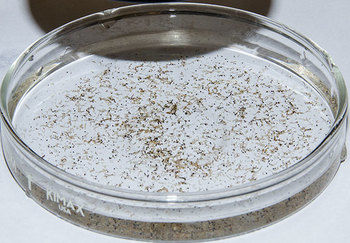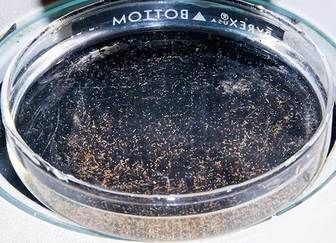Enumeration of Spores
There are various ways to count the number of spores in a sample; we first describe here the method most usually used at INVAM. Older methods follow.
Ocular Field
- Record the amount of inoculum used for the spore extraction.
- All of the extraction should be in a plastic petri dish to count spores because the base of the plate is flat. Because the dish also is hydrophobic, enough water must be added to have complete coverage of the base.
- Extract spores and use sieves to separate out as much root and organic detritus as possible, add the spore suspension to a petri dish and then randomly rotate the dish to spread out spores as evenly as possible. Note: This method will not work for extracted spores that have been stored more than 24 hr because aggregates invariable will form.
If there are less than 2 spores per field, count the entire area of the dish. Calculate average number of spores per ml of inoculum.
| D. heterogama extract | Gi. rosea extract |
|---|---|
 |  |
If there are more than 2 spores per field, then place a 1 cm grid the size of the petri dish (printed on acetate) under the plate and choose a minimum of 10 1 cm squares. Count spores in each square and multiply by number of squares on grid for estimate of number of spores per ml inoculum.
Direct Counts (low density)

When there are less than 3-4 spores some fields of view and no spores in others (25-50% of fields examined), then the method above cannot be used because it will overestimate total number of spores in the sample. In this case, spores often are few enough to be counted directly.
- Transfer spore suspension to a test tube, vortex, and transfer 1 ml to a watch glass. Perform this step three more times to count spores in four replicates.
- Swirl water in watchglass (clockwise or counterclockwise) to concentrate spores in the center. Expand field of view to see all spores and make a direct count. Average the counts from four watchglasses and multiply result by dilution factor (1/x total mls in test tube).
- If number of spores in watchglass is too many to count comfortably, then increase the dilution and recount.
Rating of Spore Abundance
Within 30 days of harvest, a rating of sporulation abundance is assigned to each active culture in the collection. We use this is relative measure as an indicator of culture productivity (see notes section of the searcheable culture database) and it has served us well for over a decade.
- A 50 cm3 sample is removed from a pot culture and spores extracted.
- The spore extract is transferred to a petri dish and the contents shaken/swirled to distribute spores as evenly as possible.
- A rating is assigned to each of five fields randomly selected across the dish. This rating varies with size of spores: (i) small (<120 µm), (ii) medium (>120 and <250 µm), and (iii) large (>250 µm).
| HIGH | MODERATE | LOW |
|---|---|---|
| small = >300 spores/mL medium = >200 spores/mL large = >100 spores/mL | small = 200-300 spores/mL medium =100-200 spores/mL large = 25-50 spores/mL | small = <100 spores/mL medium = <80 spores/mL large = <20 spores/mL |
| Photos of fields exemplifying ratings of small-spored Acaulospora morrowiae | Photos of fields exemplifying ratings of medium-spored Archaeospora leptoticha. | Photos of fields exemplifying ratings of large-spored Gigaspora gigantea |